The lively city of Leipzig is the largest in the east German state of Saxony.
It might not be the capital (nearby Dresden takes that honour) but its rich history, cultural scene and architecture make it a must-visit location on a trip to the state.
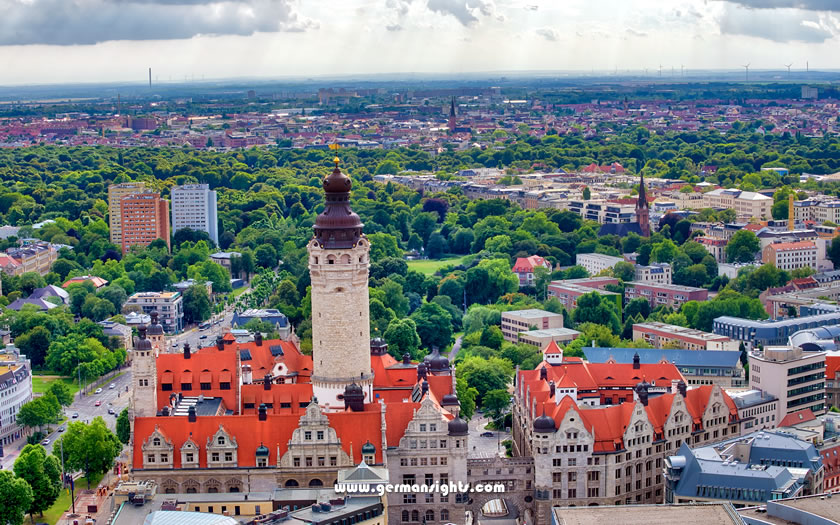
A view over the city centre of Leipzig
Unique aspects include the beautiful Old Town, numerous museums and lively neighbourhoods with a mix of architectural styles. Famous composers such as Bach and Mendelssohn lived and worked here, testifying to its cultural heritage.
Train buffs will enjoy the fact that Leipzig is also home to the largest railway station in Europe.
Compared to other German destinations, Leipzig is less crowded but still offers great attractions. The city is also more affordable so visitors can explore the city without breaking the bank.
Leipzig is located in eastern Germany between the rivers Elster, Pleiße and Parthe.
It is around 160 kilometres (100 miles) southwest of Berlin, the country's capital. Dresden, the capital of Saxony, is about 120 kilometers (74 miles) east of Leipzig.
Leipzig/Halle Airport (LEJ) is an international airport located in Schkeuditz. It is situated roughly halfway between the cities of Leipzig and Halle, and serves both regions.
It is one of the busiest airports in Germany and is a hub for several freight airlines, including DHL Aviation and AeroLogic.
The airport has two passenger terminals: Terminal B for mainly low-cost airlines and Terminal A for all other airlines. The terminals are connected by a shuttle bus that operates every few minutes.
Leipzig/Halle Airport offers flights to a variety of domestic and international destinations, primarily within Europe but also some long-haul routes to North America and Asia.
From the airport, the regular S5 S-Bahn line runs to Leipzig Hauptbahnhof, the city's central train station, or to Leipzig Messe, for trade fairs.
Although the local airport is just outside the city, other more distant options may well prove to be more convenient.
Distance to Dresden Airport: 116km
Distance to Berlin Brandenburg Airport: 186km
Distance to Václav Havel Airport Prague: 229km
Although the airports at Dresden and Leipzig do offer some European city destinations and carriers, the largest choice is going to be either at the airport in Prague or at the new airport at Berlin Brandenburg.
Leipzig Hauptbahnhof, the city's central train station is located just outside the city centre. The station is one of the largest in Germany.
There is an extensive network of regional train services and the suburban S-Bahn connections to local towns and villages. The train station is also served by several long-distance express ICE routes from cities like Berlin, Munich and Frankfurt.
Leipzig has a good public transportation system, which includes trams, buses, and suburban trains (S-Bahn).
The city's public transit company is Leipziger Verkehrsbetriebe (LVB). Tickets can be purchased at ticket machines, LVB service centres, or on board buses and trams.
Special tickets include the Leipzig Card and the Leipzig Regio Card, which offer unlimited travel within the city and additional benefits.
The Leipzig Card covers public transportation within the city and provides discounts on attractions, tours, and cultural events. The Leipzig Regio Card extends the coverage to nearby towns and offers similar discounts.
Leipzig offers a range of accommodation options catering to different preferences and budgets. Here are some of the best places to stay in the city:
If you know when you are planning to go but haven't decided on accommodation, then use the map below to get an idea of which properties are available and to compare prices during the period you wish to travel.
Enter your proposed dates and use the '+' to zoom in on a location and reveal more properties. Click on the price above a property to see more information.
(Please note that this selection will also include some guesthouses, pensions and self-catering apartments for those who are interested in that form of accommodation!)
If you know when you are planning to go but haven't decided on accommodation, then use the searchbox below to get an idea of which properties are available and to compare prices during the period you wish to travel.
The name Leipzig is derived from the Old Sorbian word 'Lipsk', meaning 'settlement where the lime tree grows'. The region was originally inhabited by Slavic tribes and the name reflects the common appearance of these trees in the area.
Archaeological evidence points to human presence in the Leipzig area as early as the Neolithic period. However, the city of Leipzig itself was first mentioned in historical records in 1015, when it was a small trading settlement under the rule of Margrave Gero.
Over time, due to its key location at the crossroads of important trade routes such as the Via Regia and Via Imperii, Leipzig developed into a major commercial centre with a strong cultural and economic influence throughout history.
Its strategic position at major European trade crossroads birthed the Leipzig Trade Fair in the 12th century.
The city has been a cultural and musical powerhouse for centuries. The St. Thomas Choir, established in 1212, is among the world’s oldest boys’ choirs. Composer Johann Sebastian Bach left his mark on Leipzig as Thomaskantor and working at St. Thomas Church. Additionally, the acclaimed Leipzig Gewandhaus Orchestra emerged in 1743.
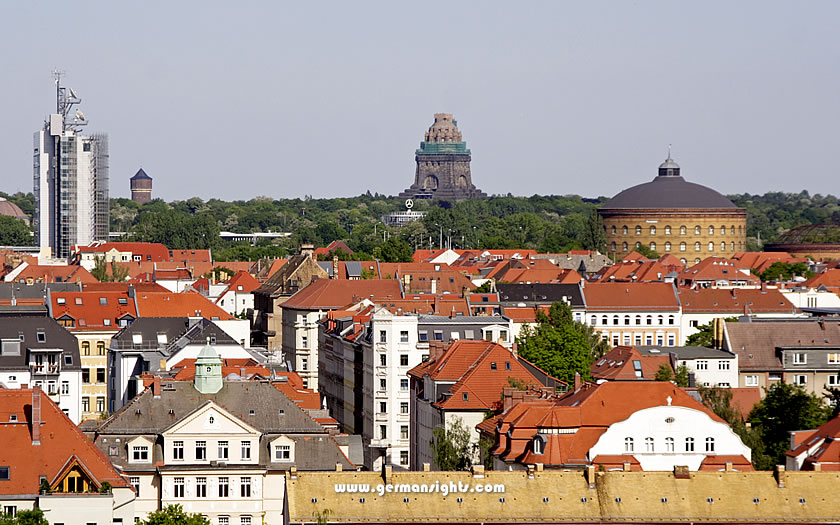
View over Leipzig looking towards the Battle of Nations monument
The Battle of Nations is also known as the Battle of Leipzig.
This momentous battle in 1813 was one of the largest in European history. It marked a turning point in the Napoleonic Wars as it eventually led to the exile of Napoleon.
Today, the Monument to the Battle of Nations stands as a testament to this crucial event, commemorating the lives lost and the city's resilience throughout history.
In the 1800s, Leipzig transformed into a printing and publishing mecca with distinguished publishers like Brockhaus and Reclam residing there. The University of Leipzig, founded in 1409, is one of Germany’s most venerable academic institutions—alma mater to philosopher Friedrich Nietzsche and chemist Wilhelm Ostwald.
Leipzig played an instrumental role in modern German history through peaceful protests at St. Nicholas Church in 1989 that ultimately toppled the Berlin Wall. These ‘Monday Demonstrations’ showcased Leipzig citizens’ dedication to freedom and unity.
Leipzig offers visitors a wide range of sights that showcase the city's history, culture and architecture.
Notable attractions include historic buildings, a well-preserved old town, fascinating museums, art galleries and impressive monuments.
The city also boasts beautiful parks, trendy neighbourhoods and culturally significant sites related to famous composers and the peaceful revolution.
St Thomas Church is a historically important church located in the heart of Leipzig.
The original church is believed to have been founded back in the 12th century. It survived the fire of 1468 and was rebuilt in the Gothic style.
St Thomas is closely associated with composer Johann Sebastian Bach. He was the church's musical director from 1723 until his death in 1750. It was here that he composed and performed many of his masterpieces with the famous St Thomas Boys Choir.
JS Bach's remains lie in state in the church, having been moved from their original grave in Leipzig's Johanniskirche in 1950.
The Thomanerchor was founded in 1212 by Margrave Dietrich of Meissen. It is one of the oldest boys' choirs in Germany, with an unbroken tradition spanning more than eight centuries.
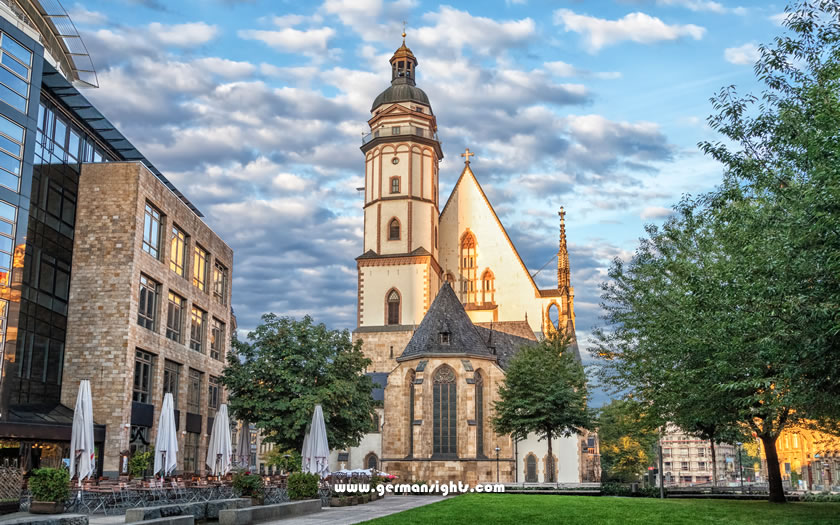
St Thomas Church in Leipzig
The impressive late Gothic architecture features high ceilings, beautiful stained glass windows, intricate carvings on the choir stalls and a baroque-style organ gallery.
The tower of the Church of St Thomas stands some 68 metres tall and provides a striking silhouette against the Leipzig skyline.
The nearby Bach Museum is dedicated to the life and works of Johann Sebastian Bach. It features historical artefacts such as manuscripts or instruments related to the great composer.
The St Nicholas Church (Nikolaikirche) was founded around 1165, which makes it one of the oldest churches in Leipzig.
The importance of this historic church increased during the peaceful revolution of 1989. The Nikolaikirche served as a rallying point for pro-democracy demonstrators during the Monday protests.

St Nicholas Church in Leipzig
The church has a fascinating mix of architectural styles due to various additions and renovations over the centuries.
The interior features intricate columns with palm leaf capitals, beautiful stained glass windows and an impressive organ with over 6,000 pipes.
Peace prayers are still held at St Nicholas every Monday to commemorate the church's role in the peaceful revolution and to encourage non-violent protest against injustice.
The Altes Rathaus, or Old Town Hall, is a prominent landmark in Market Square.
Constructed in 1556 under the guidance of architect Hieronymus Lotter, the town hall exemplifies the beauty of Renaissance architecture. The building features a distinct facade with intricate detailing and ornamentation.
The Altes Rathaus is not just a stunning architectural sight but also home to the Stadtgeschichtliches Museum (Museum of City History). The museum offers insight into Leipzig's rich history through various exhibits, period rooms, and collections.
The Museum of Fine Arts (Museum der bildenden Künste) in Leipzig is a renowned art museum that houses an extensive collection of paintings, sculptures, and graphic art from the Middle Ages to the modern era.
Located in a modern, glass cube-style building, the museum offers an impressive contrast between its contemporary exterior and the centuries-old artworks within.
The collection features works by both internationally recognized and local artists, such as Max Klinger, Neo Rauch, and the Leipzig School.
The Battle of the Nations Monument (Völkerschlachtdenkmal) in Leipzig is an imposing structure that commemorates the decisive Battle of Leipzig, which took place in 1813 during the Napoleonic Wars.
The battle, also known as the Battle of Nations, saw the allied forces defeat Napoleon's army. It was a significant turning point in European history.
The monument, completed in 1913 on the battle's centenary, is one of the largest monuments in Europe. Designed by German architect Bruno Schmitz, the structure features impressive sculptures and an exhibition hall.
Visitors can climb steps up to a platform which enjoys panoramic views of Leipzig and the surrounding areas.
The Leipzig Regio Card is a help for a local day trip near Leipzig. It covers public transport operated by the MDV (the public transport company for the Leipzig region) as well as offering reductions on entrance tickets to attractions.
Visitors who are planning to travel a little further afield might also want to look at the Sachsen-Ticket from the German rail service Deutsche Bahn (www.bahn.de). This offers a whole day's travel on regional rail services for up to five adults, and includes destinations in the whole of Saxony as well as the neighbouring states of Saxony-Anhalt and Thuringia.
Those who would like to get out and about in some natural surroundings might like to explore the Leipziger Neuseenland.
This is a collection of artificial lakes around Leipzig formed from the remains of open-cast mining in the area and is popular both for sightseeing and water sports.
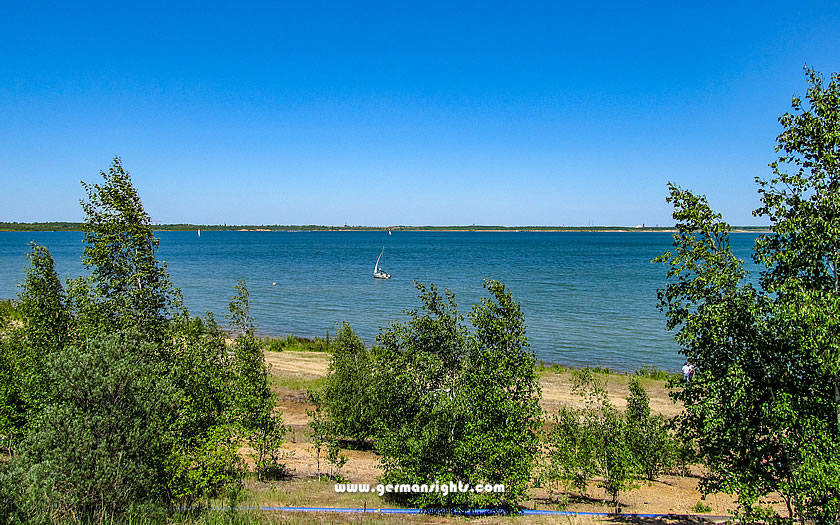
The Zwenkauer See near Leipzig
Colditz Castle is a historic castle around 45 kilometres south-east of Leipzig. It gained notoriety during World War II when it was used as a high-security prisoner-of-war camp for Allied officers who had escaped from other camps.
Visitors from certain generations in the UK may also remember the very popular TV series based on the events in the castle shown in the 1970s.
The castle can be reached by public transport from Leipzig and is open every day.
Naumburg is a picturesque town located on the banks of the Saale River in the neighbouring state of Saxony-Anhalt. It is aroud 60 kilometres south-west of Leipzig and can be reached by regional train services.
Naumburg cathedral is listed as part of the UNESCO World Heritage and the market square is surrounded by half-timbered houses and historic buildings.
Leipzig hosts several notable events throughout the year, including:
The Leipzig Book Fair is a major literary event held in March, attracting authors, publishers, and readers from around the world.
The Bachfest Leipzig (Leipzig Bach Festival) is a music festival in June, celebrating the works of Johann Sebastian Bach.
The Wave-Gotik-Treffen is one of the world's largest gothic and alternative festivals, held each year during the Whitsun weekend.
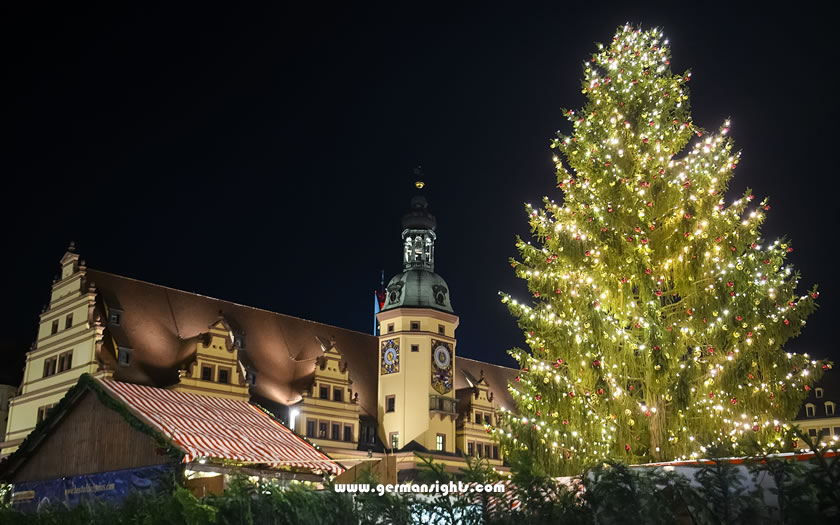
Christmas market in the old town of Leipzig
Leipzig Christmas Market dates back to the 15th century and is held in the Advent period in various squares and streets around the city. More information about Leipzig Christmas Market.
The Leipzig Tourist Office is located between Marktplatz and the main train station near the entrance to the Museum der bildenden Künste (MdbK). The office is open seven days a week, with slightly shorter opening times on weekends and public holidays.
Website: www.leipzig.travel